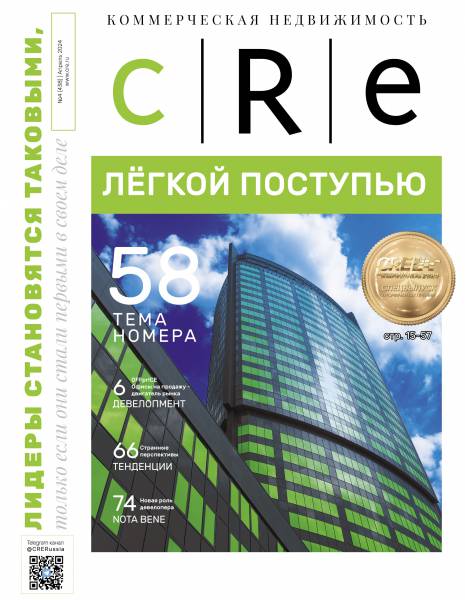The situation on the Russian real estate market in 2010 had improved greatly, although transactions involving foreign institutional investors were quite rare. After the disastrous year 2009, Jones Lang LaSalle says that last year the total volume of investment transactions in the market increased by 24%, up to $3.96 billion. VTB Capital, which represents the investment business of the VTB Group, puts this total at $3–3.5 billion, slightly higher are the figures given by the Renaissance Capital – $3.5-4 billion.
There is no doubt that the office segment is leading the way, becoming Number One both in the quantity of transactions and in capital inflows. According to Jones Lang LaSalle, this segment accounts for 56.6% of all total investments (Fig. 1). “The significantly decreased prices per square meter, during the recession, had an impact on the attractiveness of the office segment for the real sector companies, which purchased objects for themselves, as well as for institutional investors,” argues Ekaterina Konstantinova, Head of Renaissance Real Estate Group, Managing Director. “Today we are witnessing a trend of office buildings going up in value. As a result, the most courageous and active players, who purchased properties in 2009 – early 2010, are already receiving an attractive return on their investments.”
The largest investment transaction in the office sector, as well as in the overall market, was the purchase of almost the entire investment portfolio of Horus Capital, in the amount of $800 million, by Boris Mints, co-owner of Otkritie Financial Corporation . Investors are attracted to already operating and quality facilities that can bring instant profits. “However, there is a shortage of standing fully operational properties of institutional quality on the market, so the prices for such assets are high, which limits potential growth of the post-acquisition yield for them” says Victor Makshantsev, Global Head of Infrastructure and Real Estate Investment Funds at VTB Capital. “In the light of that, investments into quality development projects are of higher interest, as well as investments into uniquely located standing property that provide opportunities for raising its profitability through its redevelopment or re-concepting.”
Domestic players prevail
The lion’s share of investments into commercial real estate, and this accounts for 74% according to JLL, comes from Russian players, the remaining 26% from foreign companies (Fig. 2). Nonetheless, analysts are noting the return of foreigners’ interest in Russia, starting in the second half of last year. Although this “interest” thus far has been limited to search and analysis of the investment attractiveness of specific objects. As a result, by 2010 Russia’s share of the global commercial real estate investment market reached 1-2%, notes Ekaterina Konstantinova. “Most foreign investment funds were even less active last year than they were in 2009, with the situation being slightly rectified towards the final months of the year,” adds Alexei Filimonov, general director of Astera International Consulting Firm. “The levels of profitability, which owners offer to investors, often do not stand up to close scrutiny.”
Globally, Russia significantly lags behind not only the developed countries (U.S., UK), but even the new players (China, India). “However, the potential of the Russian real estate market is higher than that of Eastern Europe, the Baltic States as well as other former Soviet countries,” says Anastasia Zalutskaya, project manager of business and investment projects at the NEO Center Consulting Group. “The higher stability of the Russian economy, thanks to the accumulated reserves, as well as the underestimation of a significant portion of assets in the real estate market, have a positive effect.”
An attractive rate of return and legislative changes designed to improve the investment climate can help in attracting foreign investors back to Russia. Among other shortcomings of the Russian market, experts name the lack of transparency in the distribution of land and the many administrative barriers facing the real estate development business. The activity of major Russian players is also an indicator to foreigners of the maturity of the market. “As soon as the RF Pension Fund starts investing in Russian commercial real estate, the Western investment funds will come,” says Alexei Filimonov. “Today only ‘second rate’ funds are operating on the real estate market, with attracted capital between $100 to $300 million, as well as industrial groups and private investors with portfolios of $20–50 million. Viktor Makshantsev of VTB Capital does not share the skepticism of his colleagues. “The interest in Russia remains and is increasing. These are not only our partners from VTBC-Ashmore Real Estate Partners I LP, but big players from Europe, the Middle East and Asia, as well. At the same time, it has become apparent that a successful entry into the Russian market is possible only in collaboration with leading local players, who can provide the necessary experience, knowledge and access to first class projects. Therefore, we expect to see a growth of foreign investments into Russian real estate through various partnership schemes.”
Maybe not as fast as we would like, but nevertheless Western investors are returning. Such international funds as Barwa Gazprombank, Jensen Russian Real Estate, and Heitman European Property Partners IV have announced plans for working in Russia. At the end of last year, the British company, Ashmore Investment Management, made its debut onto the Russian market by purchasing Deutsche Bank’s share in VTBC-DB Real Estate Partners. Since the number of investment funds, announcing their intentions to enter the market, keeps growing, Jones Lang LaSalle is forecasting an increase in the number of transactions involving international capital.
Among the transactions that took place last year, we should mention the purchase of the Green Wood Business Park by the Chinese state company, “Center for Trade Development and Investment Management in Europe”, the Bakhrushin House Business Center by the UFG Asset Management Fund, the Capital Plaza Business Center by the VTB Capital, as well as the Geneva House by the Swiss Eastern Property Holdings.
Bronze medalist
Last year, Moscow became the third city in Europe in terms of investments into commercial real estate, yielding only to London and Paris. “Of course the country’s capital remains the most attractive region in the real estate market,” says Victor Makshantsev. “Moscow features the highest concentration of prime quality projects; average size of transactions is generally larger than in other regions.” Alexey Filimonov provides another argument, “The reality is such, that only capital city projects, and only those within the Garden Ring, are able to provide investors with the necessary level of profitability and liquidity.”
“Investors are first returning to the markets of Moscow and St. Petersburg, being more familiar with these,” says Yulia Gordeeva, senior real estate analyst at Deutsche Bank. “Historically, the capital city has been the center of foreign capital investments, while the Russian players invested in St. Petersburg.”
It is significant that all the large transactions on the Moscow market were concentrated in business districts. The Horus portfolio ($800 million), business centers North Tower ($260 million), Western Gate ($160 million), Volna ($140 million), Ulansky ( $37 million), etc. The ban on new office construction projects within the Third Ring Road (TRR) by the city’s administration, in the future will have a positive impact on the prices of existing facilities located within the Garden Ring. Among the most significant transactions in other commercial real estate segments we can mention the purchase of the Tomilino Logistics Park at a price of $39 million by Sberbank, and the acquisition of the Europark Shopping Center, at the price of $60 million, by Tashir Group.
In light of the upcoming Sochi Olympic Games in 2014 and the Football World Cup 2018, it appears that the regions also have some investment potential, above all, in the hotel segment, says Anastasia Zalutskaya.
Back to development
As the real estate market recovers, banks are becoming more willing to lend money to builders. Mainly residential housing and commercial landmark sites, such as Moscow-City are receiving funding. “Major developers are now able to borrow rubles for about 9.5–13.0%, depending on the size and financial condition of the company, whether it is a funding project or not, and on the readiness of the facility. Today, interest rates are very close to their pre-recession levels, making financing affordable, in terms of total cost,” says Yulia Gordeeva.
Many developers have already announced the resumption of their construction projects, which had been frozen during the recession. For example, Don-Stroy Development, having received a credit line from Sberbank, this year intends to return to the construction of Oruzheiniy center in Moscow. The same Sberbank has allocated $11 million for the construction of the ALCON Business Center on Leningrad Prospect in Moscow.
While banks remain selective in their lending, Olesya Cherdantseva, director of market analysis and retail property investments at Jones Lang LaSalle, is predicting lending rates to increase in 2011, as the key interest rates grow. “In fact, lending rates have started going up even last year,” notes the expert.
For the first time in two years, developers are announcing not only the resumption of their previously frozen construction projects, but also the start of the new development projects. Thus the Russian Atomstroykompleks and the Finnish company SRV recently announced a joint multifunctional skyscraper construction project in Yekaterinburg, consisting of hotel, office and entertainment centers. Another example is the Austrian developer Raiffeisen Evolution Project Development GmbH, which has started the construction and marketing of a class A business center on 119 Leninsky Prospect in Moscow.
A new watershed
Capitalization rates for high-quality facilities in Moscow continue to fall and have almost reached their pre-recession levels – in the office segment they are approaching 9–10%, in the commercial segment – 10–12% and 10.5% in the warehousing segment. Market players are predicting a further decline in rates, in the medium term. Ekaterina Konstantinova predicts that in the second half of 2012, first-class office buildings in Moscow may be sold at capitalization rates of 7.5–8%. The current capitalization rate is still considerably above the levels of 5–6%, prevalent in the markets of Western and Central Europe, which is an additional incentive for foreign investors.
In general, market players are optimistic about the future. Jones Lang LaSalle predicts a 30% growth of investments into commercial real estate in 2011 up to $5.2 billion. Gradually, international investors will come back to Russia, where compared to the developed markets of the U.S. and Europe, the capitalization rates are more attractive and the economic situation is more favorable.
As the market grows stronger, analysts are predicting a new wave of asset redistribution on the market, which may already happen in 2011–2012. Today, the key owners of assets are non-core investors - banks that have received objects in lieu of debts, and commodity companies that took advantage of the opportunity to buy property at low prices. For both of these, except for companies buying offices for themselves, real estate remains a non-core investment. Therefore, as soon as the market can offer financial institutions and real sector companies a good price, they will gladly dispose of these assets.
не указано
Slowly but Surely Investors Return
For the first time since the recession started, commercial real estate market players are starting to talk about growth in investment activities. And even if the volume of investment transactions is below what it was in 2008, and Western investors are still not that active, interest in Russia is growing – and this is important.
15.03.2011

418

Коментарии (0)
Чтобы ответить войдите









